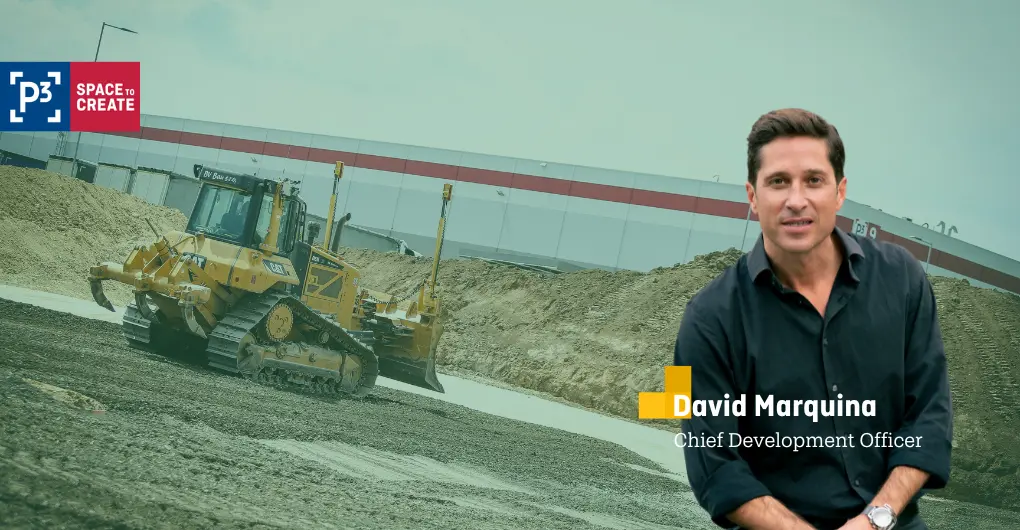

After P3 set a new record for completed development, Chief Development Officer for Europe, David Marquina, says understanding customers reduces disruptive influences.
What was the state of play in European logistics at the end of 2022?
Essentially, it was a year marked by low predictability in which it was – and still is – hard to see what comes next. The market has been impacted by many disruptive influences including rising costs for land and construction materials, disturbed supply chains, inflation, and in some markets shortages of materials, labour; the list goes on. As a result, some customers needed to adjust their strategies and pulled out of some expansion projects, which put even more pressure on developers like us.
‘Amid all of this, at P3 we still set a new company record of almost 594,000 sqm of completed development projects in 2022. So there are positives, not least the logistics market itself, which continues to demonstrate resilience and favourable long-term demand due to e-commerce. We have a really low vacancy rate, probably a record low with occupancy at 98% – like other players have at this time. Also, recently we’ve seen construction costs stop growing and come down a bit which is positive, and hopefully that’ll continue. Why the drop in costs? Some players decided to pull out of markets by adopting a wait-and-see position, so we’re in a place without that many new projects starting, which is driving down construction costs.’
What is your pipeline like for 2023, so far?
‘We started the year successfully with the delivery of a Build-to-Suit (BTS) development of more than 29,000 sqm to Groupe CAT, in Spain. Currently, we have 355,000 sqm under construction across Europe, following on from 2022 when 382,000 sqm of development was started, which was actually below our average, mainly due to the disruption just mentioned.
‘In the north of France we are currently building a new logistics centre on the largest site yet acquired by our French team. It’s our first multi-warehouse park in the country and when complete, P3 Laon will comprise three warehouses across 130,000 sqm. In Poland we are currently developing a total of 163,000 sqm at five locations, while we plan to complete 70,000 sqm of speculative space at three locations in the Czech Republic by mid-2023. Also, in Germany we are about to start two projects totalling 173,000 sqm, in addition to a 39,000 sqm brownfield site currently under redevelopment near Stuttgart.
How important are speculative developments for P3 compared to BTS?
‘We have a strong record of speculative developments at P3, which allow us to respond more quickly to the high demand for space in the market. Of the 355,000 sqm we are currently developing, 83% is speculative. The key is to invest in strategically located sites that meet the demand of costumers. We manage to lease most of our speculative developments completely during the construction process.
But still, BTS can be more attractive to developers than speculative development, for which you need very strong rationale on land price, location, future rent value, etc. Whereas when you have a client who wants a BTS, these factors become minimal. Often, municipalities are most interested in choosing a developer that brings a specific customer at the outset, in order to know the business they will welcome to the local community. In such cases, we favour the BTS approach. Currently, we are working with several customers on new opportunities that include some larger land acquisitions.’
The size of P3’s landbank is growing, why’s that?
‘It’s true we currently own a land bank with 1.9 million sqm of potential lettable area. Basically, if you want to be able to do development in the years ahead, then you need to take care of your landbank now. Acquiring land is a lengthy process; it’s not like asset acquisitions where you identify a yielding property, buy it and then it’s in your portfolio, generating income. With land banking it takes a long time to secure a plot and navigate regulations, zoning, permitting, and so on. And of course, there needs to be a customer to make it all worth it. The whole process can take up to four years.
‘Every market is different in this regard and some have more land than others; for example, Poland has lots of land available and is a flat market, but has a rapid permitting process, which makes the process efficient to manage. Then there are places with higher land scarcity and more regulations and restrictions, like the Netherlands and France, where the process of getting the permit is especially lengthy. Every market and every deal is specific, so you need to gain a very good understanding of it.’